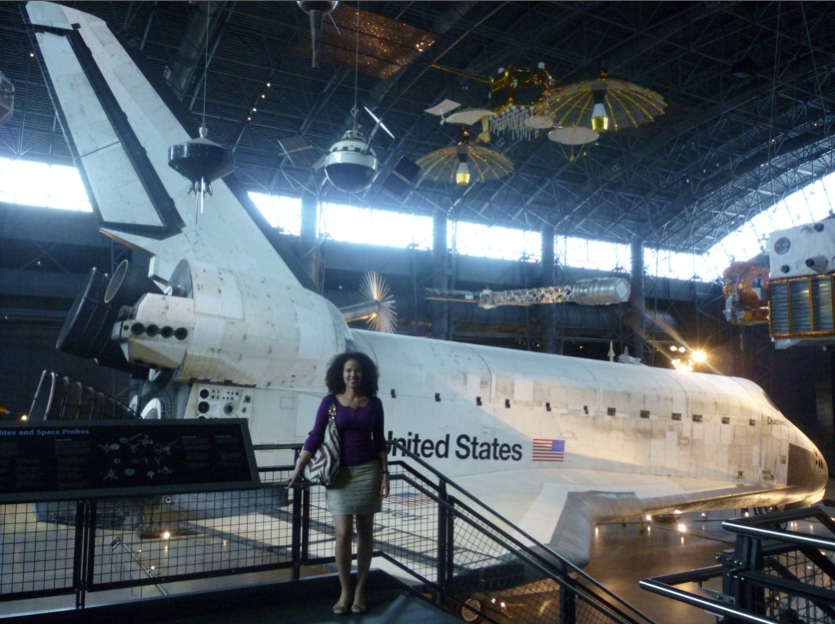Rediscovering Discovery: A SpacePolicyOnline.com Commentary–Photos Added
Editorial Commentary by Laura M. Delgado after visiting the Discovery space shuttle orbiter at the Smithsonian’s Udvar-Hazy Center. This story has been updated adding photos of the visit.
Having never visited the National Air & Space Museum (NASM) Steven F. Udvar-Hazy Center in the few years I have been living in DC is akin to going only sporadically to the beach when I was growing up in Puerto Rico. Embarrassing, yes, but so easy to do. That’s why this past Saturday when a friend (with a car) suggested venturing out to Chantilly, VA, I simply could not refuse.
We did not get to see Space Shuttle Discovery right away. After a persistent rain had cleared away, we took the opportunity to go up to the observation tower and see planes coming in and out of Dulles International Airport just a few miles away. As we picked up new facts about flying, we heard the real-time talk of flight controllers and saw blips of planes in the vicinity of the Newark airport in New Jersey on a radar screen.
Back in the main building, we went to the Boeing Aviation Hangar first and were just awestruck at the many kinds of engines, models and planes that are packed up in that one space. We picked our favorites (based on color, symbols on the wings, size or shape) and got up for a closer look: a World War II German plane, the French Concord, and a couple of colorful aerobatic aircraft made the cut. The sampling was enough for us to comment often on the bravado of those who had braved the skies for the first time in such fantastic-looking vehicles.
Eventually, of course, the pull of the Space Shuttle, sitting silently in the middle of the James S. McDonnell Space Hangar, was just too strong.
I had seen Discovery once before. Back in April, before it moved into its new location, it sat on top of what seemed a gigantic plane that flew over the city, drawing the gaze of thousands. I was one of so many who clambered up to the rooftop of their buildings, hoping to catch a glimpse of it. And we did — on its way from Dulles and into the city, Discovery flew over us in Arlington, Va., not once but three times, giving us different perspectives and making us clap and scream with inexplicable joy.
At the museum, of course, the experience was quieter.
I gazed at the vehicle with an interesting mixture of disbelief – at both how small and how big it looked, at how seemingly fragile – and of certainty, as I recalled what several years of being in the space policy field have taught me about the program. The many successes, the failures, and the history of its conception and its closure, were all remembered in that one moment as I tried to angle my camera just right to capture it in its entirety. The scuff marks, the dust and grit, the instructions to astronauts written in bold letters, the thermal tiles – those tiles, that featured so prominently for the Nation in 2003 – all of this caught my attention as I circled Discovery.

Space Shuttle Orbiter Discovery at the James S. McDonnell Space Hangar of the Smithsonian Institution’s National Air and Space Museum’s Udvar-Hazy Center, August 2012. Photo Credit: Laura M. Delgado

SpacePolicyOnline.com correspondent Laura M. Delgado poses next to the space shuttle Discovery orbiter at the James S. McDonnell Space Hangar of the Smithsonian Institution’s National Air and Space Museum’s Udvar-Hazy Center, August 2012. Photo Credit: Laura M. Delgado
While my connection to space is policy not technical, I have to admit that in this one moment, I felt the shuttle to be quite real. Everything about it, what I know, what I will keep learning and what I don’t yet understand, was evidence to me that I was looking not at a symbol but a real component of the space program.
I saw many things on Saturday that surprised me, made me wonder, but the privilege of seeing Discovery up close for the first time definitely stayed with me. Yes, Discovery, like the other shuttles, is not flying any more. But for those of us who venture out to see them, it’s like getting a flavor of space and our history in it in a very personal way while inviting an opportunity to ponder over and hope for what comes next.